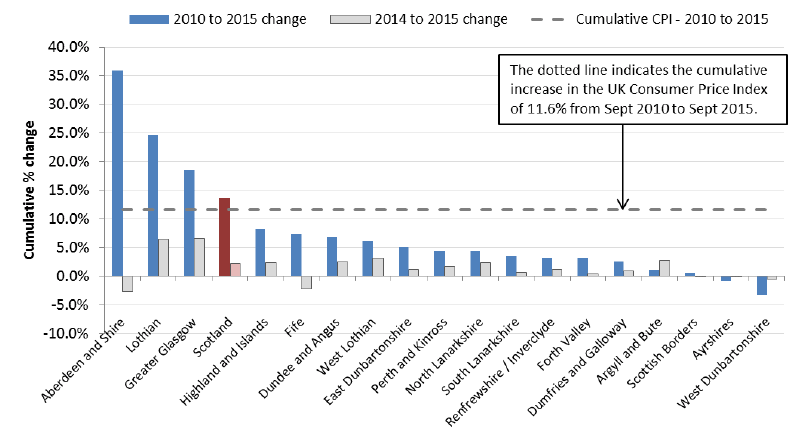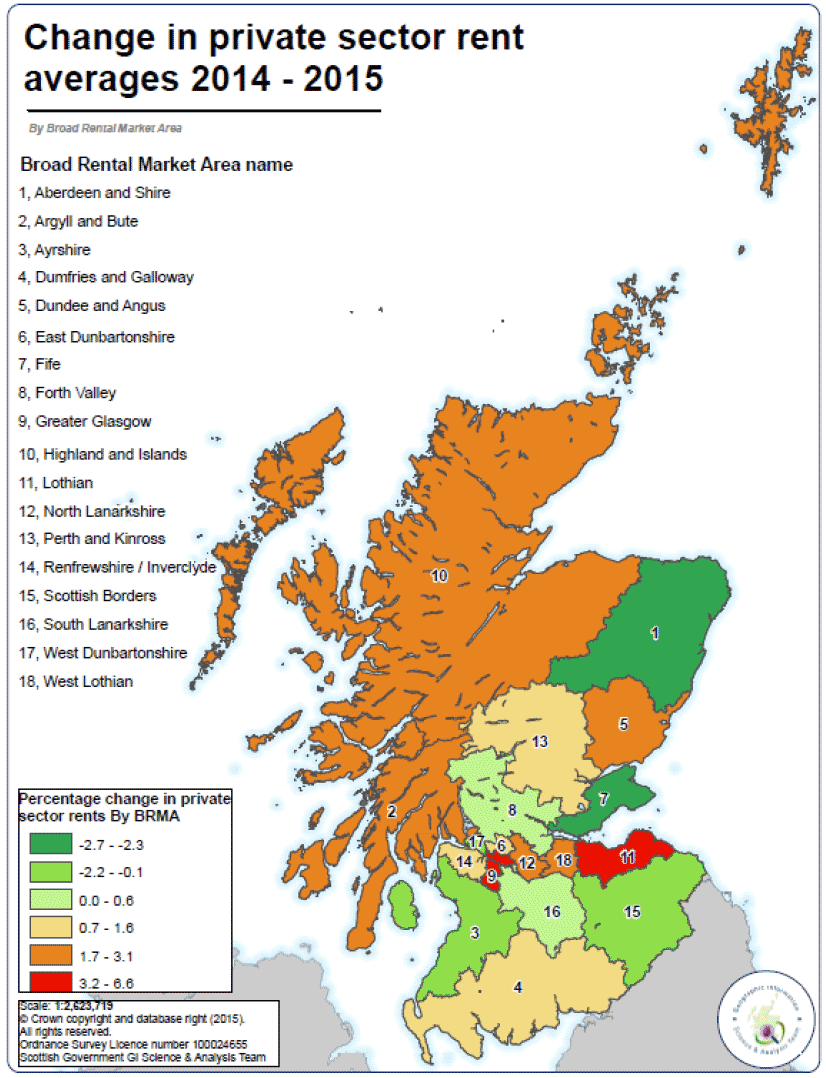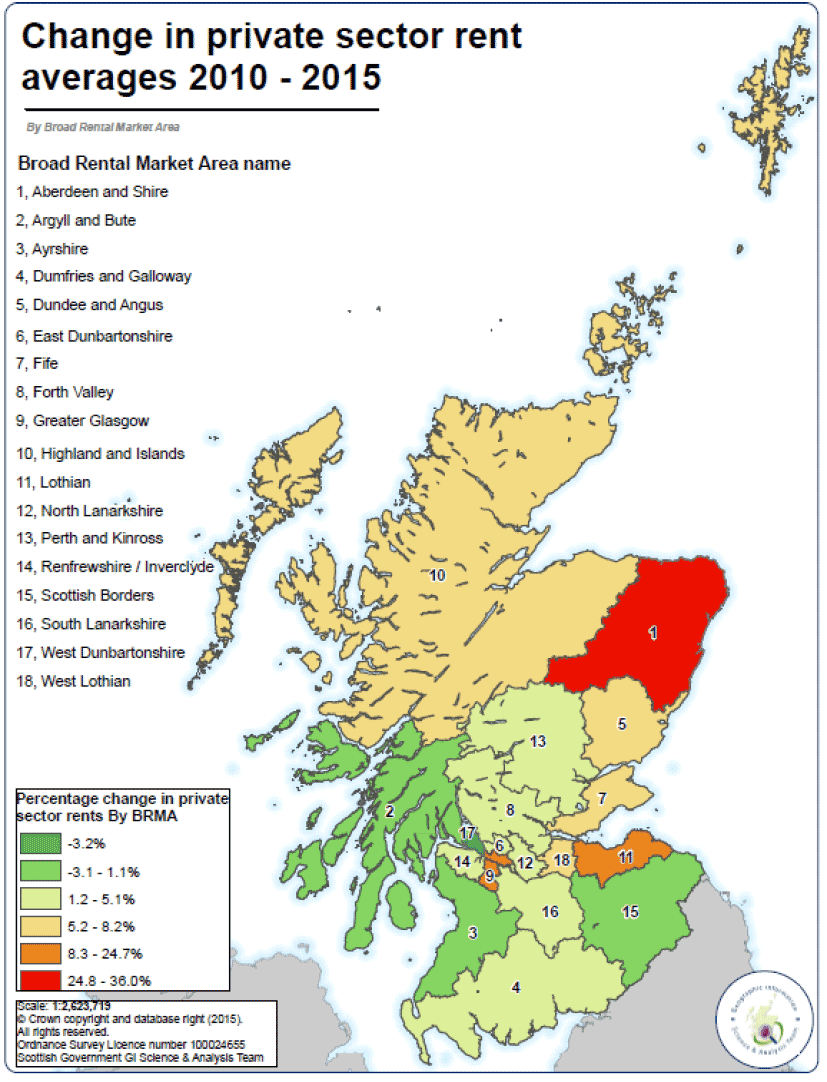Private Sector Rent Statistics: 2010 - 2015
This publication presents statistics on private sector rent levels in Scotland over the years 2010 to 2015 (years to end-September) using data from the Rent Service Scotland market evidence database. It presents information on rent levels for different property sizes across each of the 18 broad rental market areas in Scotland. It contains information on average rents as well as rents at the higher and lower end of the market.
Main findings
Main findings for average rent changes in the latest year (2014 to 2015)
- From 2014 to 2015, 13 areas have seen increases in rent for 2 bedroom properties and 5 areas have seen a decrease. These regional trends combine to show a 2.2% increase in average rents between 2014 and 2015.
- There were increases in average rents for all other property sizes of 1.6% for 1-bedroom, 2.8% for 3-bedroom, 1.3% for 4-bedroom and 3.0% for 1-bedroom in shared properties.
Main findings for average rent changes between 2010 and 2015
- For 1, 2 and 3 bedroom properties, average rents have increased above the rate of inflation between 2010 and 2015 in Aberdeen and Shire, Lothian, and Greater Glasgow, with all other areas of the country seeing below-inflation changes in average rents for these property sizes.
- For 4 bedroom properties, average rents have increased above the rate of inflation between 2010 and 2015 in 10 out of 18 areas of the country.
- For 1 bedroom shared properties, average rents have increased above the rate of inflation between 2010 and 2015 in Aberdeen and Shire, Fife, Greater Glasgow, and Perth and Kinross.
CHART 1: Cumulative % Change in Average (mean) Rents from 2010 to 2015 (years to end-Sept), by Broad Rental Market Area - 2-Bedroom Properties

This publication presents statistics on private sector rent levels in Scotland over the years 2010 to 2015 (years to end-September) using data from the Rent Service Scotland market evidence database. It presents information on rent levels for different property sizes across each of the 18 broad rental market areas in Scotland[1]. It contains information on average rents as well as rents at the higher and lower end of the market[2].
It is important to note that the data collected on individual rents may encompass different property types and addresses for each data collection year, and that this publication is not an attempt at providing a case-matched, tracked-sample or weighted-index approach to monitoring changes to rent levels over time. See Annex D for further information on methodological differences to the ONS Index of Private Rents.
Main Findings for 2 bedroom properties
The most common type of property in the private rented sector is a 2 bedroom property. Findings relating to other types of properties can be different to those for 2 bedroomed properties, and information on them is provided later in this publication.
- From 2014 to 2015, 13 areas have seen increases in rent for 2 bedroom properties. These ranged from 6.6% in Greater Glasgow and 6.4% in Lothian to 0.6% in South Lanarkshire and 0.4% in Forth Valley. Five areas saw decreases, these were Scottish Borders (-0.1%), Ayrshires (-0.1), West Dunbartonshire (-0.5%), Fife (-2.3%) and Aberdeen and Shire (-2.7%).
- These regional trends combine to show an increase of 2.2% in average rents for 2 bedroom properties from 2014 to 2015.
- For the year to end-September 2015, Aberdeen and Shire had the highest average monthly rents for 2 bedroom properties across Scotland (£874). Other areas with high rents included Lothian (£829), Greater Glasgow (£668), and East Dunbartonshire (£611). Areas with the lowest average rents for 2 bedroom properties included Scottish Borders (£444), Dumfries and Galloway (£446), and the Ayrshires (£461).
- Figures on changes to rents over the period from 2010 to 2015 should be considered in the context of the cumulative increase in the UK Consumer Price Index of 11.6% from Sept-10 to Sept-15[3]. For example, over the 5 year period, average rents for 2 bedroom properties in the Aberdeen and Shire, Lothian and Greater Glasgow areas have risen faster than the consumer price index, whilst changes in average rents for 2 bedroom properties in other areas of the country have been below the rise in the consumer price index.
- These regional trends over the 5 year period combine to show a 13.7% cumulative increase in average rents from 2010 to 2015 for 2 bedroom properties at the Scotland level.
The changes in average rents for 2 bedroom properties between 2014 to 2015, and 2010 to 2015, are illustrated in Figure A and Figure B.
Figure A helps to illustrate the variation across the country in average rent changes over the from 2014 to 2015 while Figure B shows the cumulative change from 2010 to 2015. A comparison of these shows that the north east of Scotland (Aberdeen and Shire BRMA) showed high increases in cumulative rents between 2010 and 2015, but this changed over the 2014 to 2015 period to being an area with decreasing average rents. To a lesser extent, Fife also showed an increase in average rents from 2010 to 2015, and a decrease between 2014 and 2015.
Figure A: Change in average (mean) rents for 2 bedroom properties between 2014 and 2015.

Figure B: Percentage change in average (mean) rents for 2 bedroom properties between 2010 and 2015.

Contact
Email: Esther Laird
There is a problem
Thanks for your feedback